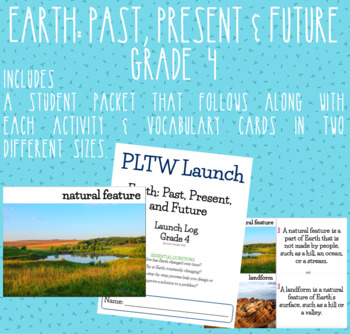Grade 4 Earth: Past, Present & Future Module
Messy Bunn Creations
99 Followers
Grade Levels
4th
Subjects
Resource Type
Standards
NGSS4-ESS1-1
NGSS3-5-ETS1-1
NGSS3-5-ETS1-2
NGSS4-ESS2-2
NGSS4-ESS2-1
Formats Included
- Zip
Pages
63+
Messy Bunn Creations
99 Followers
What educators are saying
This was my first year implementing PLTW in the classroom and this resource was a life saver! It followed the lesson so well and really helped me with my instruction and gave me something that I could use to easily assess student understanding.
My students are able to reflect on all of their learning throughout the modules. I love that they are able to go back and easily find definitions and update their thoughts.
Description
**You MUST have PLTW Launch in order to use this resource! Otherwise, it will not make ANY sense!**
This resource includes the launch log, and vocabulary cards for the Earth: Past, Present & Future Grade 4 module.
I made my own packet that follows along with each activity, similar to the K-2 versions. I print them front to back and staple as a packet that they will use throughout the whole module. The vocabulary cards come in 2 sizes. I usually print them out on cardstock and laminate them. But you do you! :)
Total Pages
63+
Answer Key
N/A
Teaching Duration
N/A
Report this resource to TPT
Reported resources will be reviewed by our team. Report this resource to let us know if this resource violates TPT’s content guidelines.
Standards
to see state-specific standards (only available in the US).
NGSS4-ESS1-1
Identify evidence from patterns in rock formations and fossils in rock layers to support an explanation for changes in a landscape over time. Examples of evidence from patterns could include rock layers with marine shell fossils above rock layers with plant fossils and no shells, indicating a change from land to water over time; and, a canyon with different rock layers in the walls and a river in the bottom, indicating that over time a river cut through the rock. Assessment does not include specific knowledge of the mechanism of rock formation or memorization of specific rock formations and layers. Assessment is limited to relative time.
NGSS3-5-ETS1-1
Define a simple design problem reflecting a need or a want that includes specified criteria for success and constraints on materials, time, or cost.
NGSS3-5-ETS1-2
Generate and compare multiple possible solutions to a problem based on how well each is likely to meet the criteria and constraints of the problem.
NGSS4-ESS2-2
Analyze and interpret data from maps to describe patterns of Earth’s features. Maps can include topographic maps of Earth’s land and ocean floor, as well as maps of the locations of mountains, continental boundaries, volcanoes, and earthquakes.
NGSS4-ESS2-1
Make observations and/or measurements to provide evidence of the effects of weathering or the rate of erosion by water, ice, wind, or vegetation. Examples of variables to test could include angle of slope in the downhill movement of water, amount of vegetation, speed of wind, relative rate of deposition, cycles of freezing and thawing of water, cycles of heating and cooling, and volume of water flow. Assessment is limited to a single form of weathering or erosion.



